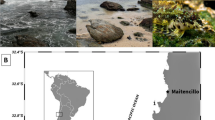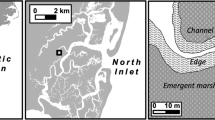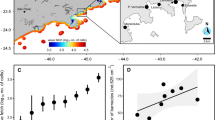Abstract
Little is known about the effects of waves on predator–prey interactions in the littoral zones of freshwaters. We conducted a set of mesocosm experiments to study the differential effects of ship- and wind-induced waves on the foraging success of littoral fish on benthic invertebrates. Experiments were conducted in a wave tank with amphipods (Gammarus roeseli) as prey, and age-0 bream (Abramis brama, B0), age-0 and age-1 dace (Leuciscus leuciscus, D0 and D1) as predators. The number of gammarids suspended in the water column was higher in the wave treatments compared to a no-wave control treatment, especially during pulse waves mimicking ship-induced waves in comparison to continuous waves mimicking wind-induced waves. The resulting higher prey accessibility in the water column was differently exploited by the three types of predatory fish. D0 and D1 showed significantly higher foraging success in the pulse wave treatment than in the continuous and control treatments. The foraging success of D0 appears to be achieved more easily, since significantly higher swimming activity and more foraging attempts were recorded only for D1 under the wave treatments. In contrast, B0 consumed significantly fewer gammarids in both wave treatments than in the control. Hence, waves influenced predator–prey interactions differently depending on wave type and fish type. It is expected that regular exposure to ship-induced waves can alter littoral invertebrate and fish assemblages by increasing the predation risk for benthic invertebrates that are suspended in the water column, and by shifting fish community compositions towards species that benefit from waves.


Similar content being viewed by others
References
Arlinghaus R, Engelhardt C, Sukhodolov A, Wolter C (2002) Fish recruitment in a canal with intensive navigation: implications for ecosystem management. J Fish Biol 61:1386–1402. doi:10.1006/jfbi.2002.2148
Backiel T, Zawiska J (1968) Synopsis of biological data on the bream, Abramis brama L. Rom. FAO Fish Biol Synopsis 36:1–120
Barton DR, Carter JCH (1982) Shallow-water epilithic invertebrate communities of eastern Georgian Bay, Ontario, in relation to exposure to wave action. Can J Zool 60:984–993
Bishop MJ (2008) Displacement of epifauna from seagrass blades by boat wake. J Exp Mar Biol Ecol 354:111–118. doi:10.1016/j.jembe.2007.10.013
Bishop MJ, Chapman MG (2004) Managerial decisions as experiments: an opportunity to determine the ecological impact of boat-generated waves on macrobenthic infauna. Estuar Coast Shelf Sci 61:613–622. doi:10.1016/j.ecss.2004.06.023
Blanchet S, Loot G, Dodson JJ (2008) Competition, predation and flow rate as mediators of direct and indirect effects in a stream food chain. Oecologia 157:93–104. doi:10.1007/s00442-008-1044-8
Borchardt D (1993) Effects of flow and refugia on drift loss of benthic macroinvertebrates—implications for habitat restoration in lowland streams. Freshw Biol 29:221–227
Bryazgunova MI (1979) Feeding relationships of the young of the pike perch, Lucioperca lucioperca, the bream, Abramis brama, and fishes of lesser importance in the lower reaches of the Don. J Ichthyol 19:57–65
Commito JA, Thrush SF, Pridmore RD, Hewitt JE, Cummings VJ (1995) Dispersal dynamics in a wind-driven benthic system. Limnol Oceanogr 40:1513–1518
Crowden AE, Broom DM (1980) Effects of the eyefluke, Diplostomum spathaceum, on the behavior of dace (Leuciscus leuciscus). Anim Behav 28:287–294
Elliott JM (1973) Food of brown and rainbow trout (Salmo trutta and S. gairdneri) in relation to abundance of drifting invertebrates in a mountain stream. Oecologia 12:329–347
Fischer P, Eckmann R (1997) Spatial distribution of littoral fish species in a large European lake, Lake Constance. Ger Arch Hydrobiol 140:91–116
Gabel F, Garcia X-F, Brauns M, Sukhodolov A, Leszinski M, Pusch MT (2008) Resistance to ship-induced waves of benthic invertebrates in various littoral habitats. Freshw Biol 53:1567–1578. doi:10.1111/j.1365-2427.2008.01991.x
Goldspink CR (1978) The population density, growth rate and production of bream, Abramis brama, in Tjeukemeer, the Netherlands. J Fish Biol 13:499–517
Hart DD, Finelli CM (1999) Physical-biological coupling in streams: the pervasive effects of flow on benthic organisms. Annu Rev Ecol Syst 30:363–395
Hart DD, Merz RA (1998) Predator prey interactions in a benthic stream community: a field test of flow-mediated refuges. Oecologia 114:263–273
Hellawell JM (1974) The ecology of populations of dace Leuciscus leuciscus (L.), from two tributaries of the River Wye, Herefordshire, England. Freshw Biol 4:577–604
Hine PM, Kennedy CR (1974) The population biology of the acanthocephalan Pomphorhynchus laevis (Miiller) in the River Avon. J Fish Biol 6:665–679
Hofmann H, Lorke A, Peeters F (2008) The relative importance of wind and ship waves in the littoral zone of a large lake. Limnol Oceanogr 53:368–380
Holling CS (1959) Some characteristics of simple types of predation and parasitism. Can Entomol 91:385–398
Kottelat M, Freyhof J (2007) Handbook of European freshwater fishes. Publications Kottelat, Cornol
Macan TT (1977) The influence of predation on the composition of fresh-water animal communities. Biol Rev 52:45–70
Malmqvist B, Sackmann G (1996) Changing risk of predation for a filter-feeding insect along a current velocity gradient. Oecologia 108:450–458
Mattila J, Heck KL, Millstein E, Miller E, Gustafsson C, Williams S, Byron D (2008) Increased habitat structure does not always provide increased refuge from predation. Mar Ecol Prog Ser 361:15–20. doi:10.3354/meps07392
Mörtl M, Rothhaupt KO (2003) Effects of adult Dreissena polymorpha on settling juveniles and associated macroinvertebrates. Int Rev Hydrobiol 88:561–569. doi:10.1002/iroh.200310640
Neverman D, Wurtsbaugh WA (1994) The thermoregulatory function of diel vertical migration for a juvenile fish, Cottus extensus. Oecologia 98:247–256
Palmer MA (1988) Epibenthic predators and marine meiofauna—separating predation, disturbance, and hydrodynamic effects. Ecology 69:1251–1259
Peckarsky BL, Horn SC, Statzner B (1990) Stonefly predation along a hydraulic-gradient—a field-test of the harsh benign hypothesis. Freshw Biol 24:181–191
Powers SP, Kittinger JN (2002) Hydrodynamic mediation of predator–prey interactions: differential patterns of prey susceptibility and predator success explained by variation in water flow. J Exp Mar Biol Ecol 273:171–187
Scheifhacken N (2006) Life at turbulent sites. Benthic communities in lake littorals interacting with abiotic and biotic constraints (Ph.D. thesis). Univ. of Constance, Constance
Schofield DK, Townsend CR, Hildrew AG (1988) Predation and the prey community of a headwater stream. Freshw Biol 20:85–95
Sih A, Crowley P, Mcpeek M, Petranka J, Strohmeier K (1985) Predation, competition, and prey communities—a review of field experiments. Ann Rev Ecol Syst 16:269–311
Sims DW, Wearmouth VJ, Southall EJ, Hill JM, Moore P, Rawlinson K, Hutchinson N, Budd GC, Righton D, Metcalfe JD, Nash JP, Morritt D (2006) Hunt warm, rest cool: bioenergetic strategy underlying diel vertical migration of a benthic shark. J Anim Ecol 75:176–190. doi:10.1111/j.1365-2656.2005.01033.x
Starry O, Wanzenböck J, Danielopol DL (1998) Tendency of the amphipod Gammarus roeseli Gervais to colonize coarse sediment habitats under fish predation pressure. Int Rev Hydrobiol 83:371–380
Stoll S, Fischer P (2010) Three different patterns of how low-intensity waves can affect the energy budget of littoral fish: a mesocosm study. Oecologia. doi:10.1007/s00442-010-1793-z
Stoll S, Fischer P, Klahold P, Scheifhacken N, Hofmann H, Rothhaupt KO (2008) Effects of water depth and hydrodynamics on the growth and distribution of juvenile cyprinids in the littoral zone of a large pre-alpine lake. J Fish Biol 72:1001–1022. doi:10.1111/j.1095-8649.2007.01780.x
Stoll S, Hofmann H, Fischer P (2010) Effect of wave exposure dynamics on gut content mass and growth of young-of-the-year fishes in the littoral zone of lakes. J Fish Biol 76:1714–1728
Warfe DM, Barmuta LA (2004) Habitat structural complexity mediates the foraging success of multiple predator species. Oecologia 141:171–178. doi:10.1007/s00442-004-1644-x
Warfe DM, Barmuta LA (2006) Habitat structural complexity mediates food web dynamics in a freshwater macrophyte community. Oecologia 150:141–154. doi:10.1007/s00442-006-0505-1
Weatherley NS (1987) The diet and growth of 0-group dace Leucicus leuciscus (L.), and roach, Rutilus rutilus (L.), in a lowland river. J Fish Biol 30:237–247
Webb PW (2002) Control of posture, depth and swimming trajectories of fishes. Integr Comp Biol 42:94–101
Weihs D (1993) Stability of aquatic animal locomotion. Contemp Math 141:443–461
Winnell MH, Jude DJ (1991) Northern large-river benthic and larval fish drift—St Marys River, USA/Canada. J Great Lakes Res 17:168–182
Wolter C, Arlinghaus R (2003) Navigation impacts on freshwater fish assemblages: the ecological relevance of swimming performance. Rev Fish Biol Fish 13:63–89
Wolter C, Arlinghaus R, Sukhodolov A, Engelhardt C (2004) A model of navigation-induced currents in inland waterways and implications for juvenile fish displacement. Environ Manage 34:656–668. doi:10.1007/s00267-004-0201-z
Acknowledgments
We thank M. Wolf for his technical support and T. Hintze for his assistance with video equipment. The manuscript benefited from the comments of K. Tockner, T. Mehner, C. Wolter, M. Brauns and two anonymous reviewers. This study was completed within the Collaborative Research Centre 454, “Littoral Zone of Lake Constance”, and was financed by the German Research Foundation (DFG), the German Federal Environmental Foundation (F. Gabel) and the German National Academic Foundation (S. Stoll).
Author information
Authors and Affiliations
Corresponding author
Additional information
Communicated by Craig Osenberg.
F. Gabel and S. Stoll contributed equally to this work.
Rights and permissions
About this article
Cite this article
Gabel, F., Stoll, S., Fischer, P. et al. Waves affect predator–prey interactions between fish and benthic invertebrates. Oecologia 165, 101–109 (2011). https://doi.org/10.1007/s00442-010-1841-8
Received:
Accepted:
Published:
Issue Date:
DOI: https://doi.org/10.1007/s00442-010-1841-8




